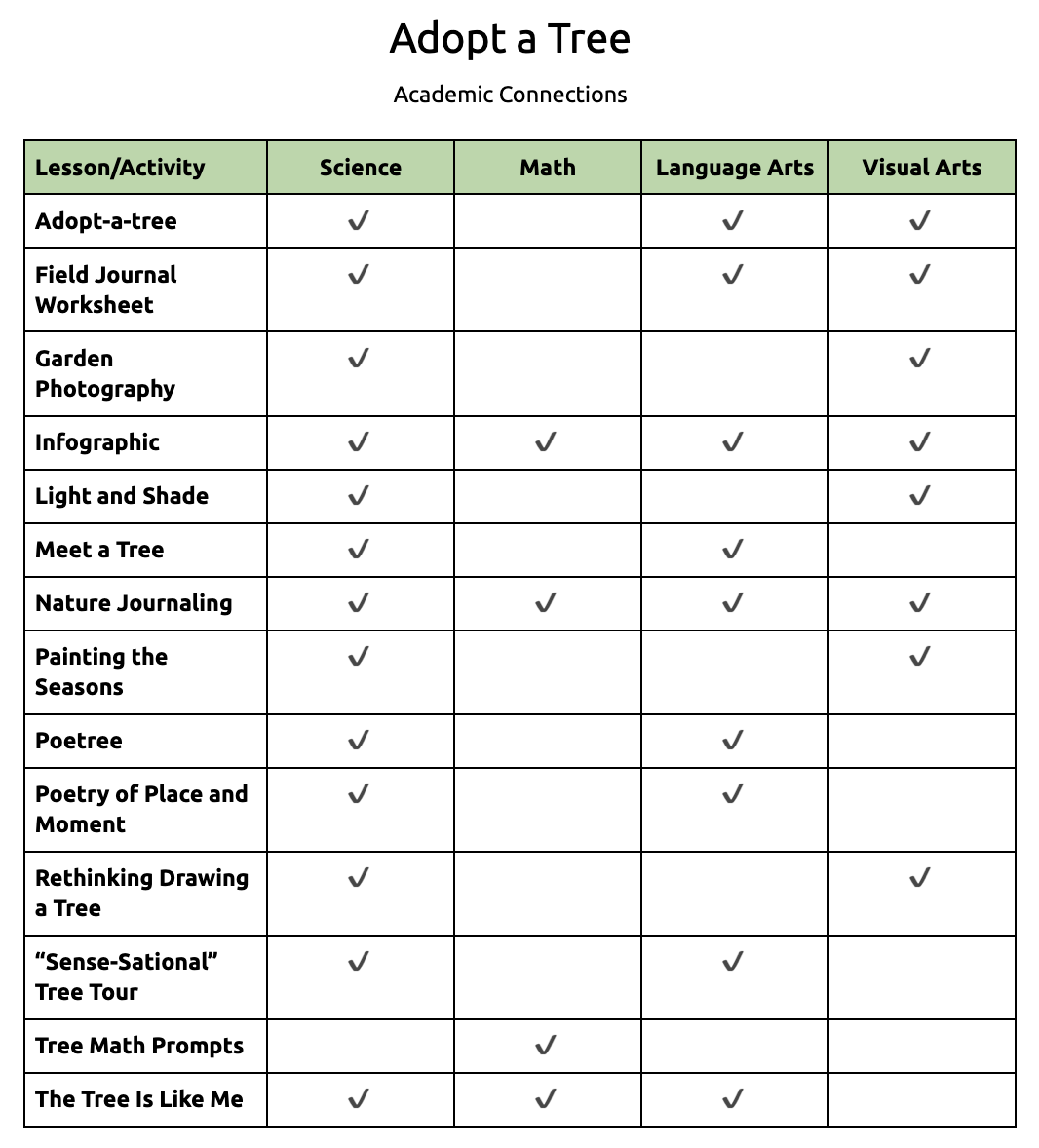Adopt a Tree - Lesson Collection
Introduction
By adopting an individual tree on their schoolyard, students start to develop a relationship with that tree, are more motivated to learn about plants and local ecosystems, develop their own expertise and richer scientific inquiries, get inspiration for art and poetry, and receive the profound mental health benefits of connection with the natural world. Students can adopt a tree as individuals or groups for a week, semester, school year, or even multiple years as they journey through grade levels. Adopting a tree can be as simple as drawing a one-time sketch, taking regular care of the tree, or engaging in deeper study of their tree tied into the science, math, language arts, and visual arts curriculum.
The lessons and activities listed here were developed by established organizations and practitioners in the field of outdoor education. These lessons and activities were chosen because they (1) include a range of skills and academic disciplines, (2) apply to saplings as well as mature trees, and (3) create a rich connection with an adopted tree.
“Knowledge without love will not stick. But if love comes first, knowledge is sure to follow. It is time enough to answer children’s questions when they are interested enough to ask them.”
Activities
We have made note of appropriate grade bands with each activity link below.
Adopt-a-Tree, PDF page 113 — Prairie Crossing Charter School
Students choose a tree to visit and observe regularly throughout the year, recording the changes that they notice over time.
Grades preK-12
Field Journal Worksheet — BEETLES
This structured worksheet is useful for written or sketched observations of a tree.
Grades 5-12
Garden Photography — KidsGardening
Students develop their photography skills by learning more about framing their shot, shifting their perspective, exploring composition, and other photography techniques.
Grades 3-12
Infographic for a Field Guide — John Muir Laws and Emilie Lygren
This activity combines writing, drawing, and data. Students combine observations of
a tree with later research to create an infographic—a great way to build science communication skills and the language arts!
Grades 6-12
Light and Shade, PDF page 141 — Karel Komárek Proměny Foundation
Capture the shadows of your tree and its branches, using paper and chalk or pencil.
Grades preK, K-5
Meet a Tree — Sharing Nature Worldwide
In this activity, one student leads a blindfolded partner to “meet” a tree and get to know it through the sense of touch. This can also be used as a trust building activity.
Grades preK-12
Nature Journaling: I Notice, I Wonder, It Reminds Me Of — John Muir Laws and Emilie Lygren
This is an excellent set of practices for developing observation and inquiry skills. This routine can be used as a once-off activity or can be incorporated into a series of nature journal pages.
Grades K-12
Painting the Seasons, PDF page 29 — Green Schoolyards America
Bring your art studio outside and create paintings of trees while observing and recording changes through the year.
Grades preK-12
Poetree — Learning through Landscapes
Students observe their tree from different perspectives to create group poems. This activity can be applied to any form of poetry being studied in the classroom.
Grades 4-8
Poetry of Place and Moment — John Muir Laws and Emilie Lygren
This activity provides a scaffold for writing poetry, linking observations to internal experiences and thoughts.
Grades 4-12
Rethinking Drawing a Tree — John Muir Laws
Observing parts of a tree rather than trying to draw the whole tree can be equally informative and less overwhelming. This two-page visual guide by John Muir Laws provides a range of strategies.
Grades K-12
“Sense-Sational” Tree Tour, PDF page 58 — Canopy
Students use their senses to get to know trees in the schoolyard.
Grades preK, K-2
Tree Math Prompts — Green Schoolyards America
A short handout to inspire teachers about math connections they can make in their schoolyard forest.
Grades K-12
The Tree Is Like Me — TreePeople
Students learn about similarities and differences between themselves and their adopted tree through this drawing and observation activity. This can be combined with the classic All About Me activity.
Grades preK, K-2
< Return to Educator Resources Home Page
Schoolyard Forest System℠
The Schoolyard Forest System℠ Resource Library is a set of practical tools for schools and districts working to increase tree canopy on public school grounds to shade and protect PreK-12 students from extreme heat and rising temperatures due to climate change. Funding for the first phase of this initiative was provided by a grant administered by the California Department of Forestry and Fire Protection (CAL FIRE) Urban and Community Forestry Program, and private philanthropy.







